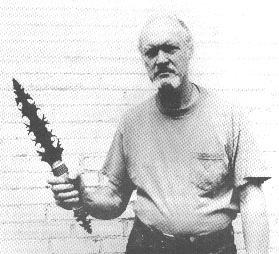Errett Callahan, MA, MFA, PhD
by EC

Background
I started knapping in 1956, at age 18, and retired from production in 2011, having then made 9,962 stone tools. I made my first hafted stone knives in 1966. In 1984 I started obsidian knife production in a big way. Since 1984, I have produced 860 stone knives, all duly signed and documented. Nowadays I just knap for the fun of it and do a little coaching (see below).
Mentors
I’d like to say I am self-taught, for I worked completely alone and without reading any instructional material for the first 10 years. My only guides were the silent ancient original artifacts. But since then, though I did not attend their classes (few taught), I’ve sat down and had intensive, hands-on instruction from the Master-level knappers- Don Crabtree, Gene Titmus, Francois Bordes, J.B. Sollberger, and Jacques Pelegrin. And that’s instruction. And I’ve read practically everything in and out of print on the subject. And that’s instruction. So I owe a debt of gratitude and thanks to these, my mentors. (I’ve also seen hundreds of other knappers work and learned countless bits of information from them. That’s learning too. )
Reinventing the Wheel
Those first 10 years were a real struggle. I had to work it all out by trial and error. I didn’t even know what the questions were, much less the answers. Sometimes I’d find myself banging away for years, making one mistake after the other, trying to isolate what causes what. As slowly as evolution itself, I eventually sorted most of it out.
All in all, I’d say I spent 20 years working my way through the Paleolithic, Paleo-Indian, Archaic, and Woodland levels and another five years working through the Mesolithic- all the while voluntarily restricting myself to replicas of ancient forms. This was my basic training and excellent discipline it was.
During the last 30 years I have been working my way through the complex Neolithic levels, finally breaking through into the unexplored Post-Neolithic territory shown herein. These latter years have also been a real struggle, for once again I’ve had little to guide me. What do you use for guidance when you’re trying to break a new trail into unexplored territory?- Only intuition.
But I don’t forget to check my backtrail to see how others are coming along. That’s why I offered my workshops. (My students are now learning in one week what it took me the first 10 years to learn on my own.) And that’s why I founded the Society of Primitive Technology in 2 1989 and served as President of the Board from 1989-1996. (See Tribute by Steve Watts in SPT Bulletin #14, in 1997.)
Education and its Relevance to Knifemaking
That MA, MFA, and PhD after my name do indeed relate to knifemaking, as Steve Shackleford alludes.
“Perhaps nowhere in the business of sharp edges does one’s background prepare him so well for his livelihood as does that of obsidian knifemaker Errett Callahan.”-Steve Shackleford, Editor, BLADE Magazine SE/OC ’87: 20.
This means that I have a masters and a doctorate in anthropology (with emphasis in lithic technology and experimental archeology respectively) and a Masters in Fine Arts. (My Master’s thesis, The Basics, is still a best seller after 20 years and four printings. It’s the basics of instruction in my workshops.) In 1992, I was awarded an Honorary Doctorate from Uppsala University in Sweden for my work on the Mesolithic and Neolithic there. Thus I am now on the faculty of Uppsala University, Archeology Department.
These degrees may not be responsible for my craftsmanship but they have indeed forced me to think hard about design, about historical context, and about field testing my products. Throughout the 1970s, I pioneered the field of “Living Archeology”, conducting subsistence projects in which participants lived off the land for from two to nine weeks under primitive conditions. We used stone knives and other primitive tools exclusively, while testing certain archeological hypotheses. When your life and very material comfort depend exclusively upon your stone tools, you learn a few things about function, design, and craftsmanship. So when I say that my knives are functional, I think I know what I am talking about. The knives shown in my catalog are the culmination of all that experience.
And now?
I have finished my book Neolithic Danish Daggers, Vol. 2 after 30 years and 250 daggers. It has been funded by you, my dagger customers, by a grant from the king of Sweden, with contributions by Jan Apel, a PhD student at Uppsala University and a fellow knapper. It will do for daggers what THE BASICS did for bifaces.
I have written a book on experimental archeology-everything I know on that too, another 15- year project. It’s titled: THE CAHOKIA PIT HOUSE PROJECT: A CASE STUDY IN RECONSTRUCTIVE ARCHEOLOGY.
Over the years I have fought hard for what is ethical in flintknapping. (Yes, there is a sordid side to our history.) I have supported and will continue to support ethical flintknapping causes. And vice versa. You can count on it.
My work is done with the conviction that I can serve best by supporting causes and revealing my so-called “secrets”. In fact, I make it my duty to see that my students can duplicate my ac- complishments. This may be easier said than done, but that’s my goal. I love teaching flintknapping.
Bud Lang, Editor of KNIVES ILLUSTRATED, says “Errett Callahan (is) a master flintknapper, instructor, etc. a gentleman who makes some of the finest obsidian knives ever created.” (KI, Oct. 1998: 4).
(Thanks Bud, but as I clearly state later on, I make no claims at being a master-though I think I am mature. Having worked extensively with the real masters, I am aware of the vast gap between them and me.)
